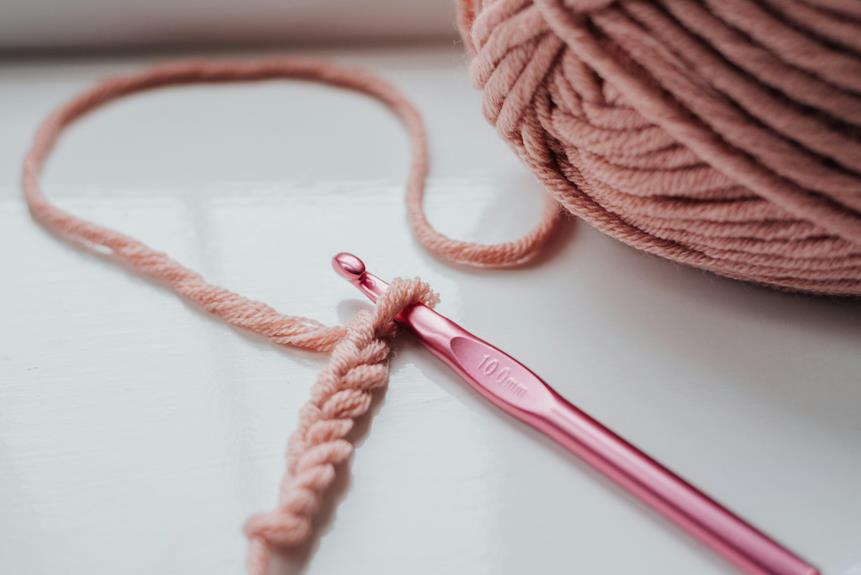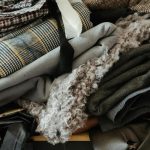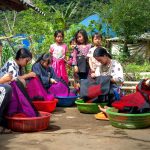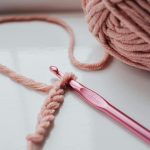When you think about authentic Madras plaid fabric, it's essential to understand the craftsmanship involved in its creation. You might be surprised that it starts with carefully chosen natural fibers like cotton or linen, and you'll appreciate the artistry behind traditional weaving techniques. As the process unfolds, vibrant natural dyes breathe life into the fabric, but that's just the beginning. You'll find that the journey of Madras plaid reflects not only skill but also cultural significance, prompting the question: what makes this fabric so unique and worthwhile in today's landscape?
Table of Contents
History of Madras Plaid
Originating in the vibrant city of Madras (now Chennai) in India, Madras plaid has a rich history intertwined with trade and cultural exchange. This distinctive fabric first gained popularity in the 18th century, thanks to British colonial trade routes connecting India to Europe and beyond.
As traders and sailors introduced Madras plaid to Western markets, its exquisite colors and patterns quickly enchanted consumers. Madras plaid originally showcased bright, handwoven cotton textiles that reflected the vibrant culture of India.
Artisans utilized natural dyes, creating unique designs that represented local motifs and traditions. These stunning patterns caught the attention of world travelers and eventually adorned everything from garments to home decor.
Selection of Natural Fibers
When you choose natural fibers for Madras plaid, identifying the right sources is crucial.
You'll want to assess the quality of these fibers to ensure durability and character.
Plus, don't forget to consider sustainability in your selection process, as it impacts the environment and the future of fabric production.
Fiber Source Identification
Selecting the right natural fibers is crucial for creating the traditional and vibrant Madras plaid fabric. You'll often encounter cotton, linen, and silk as the preferred choices for this fabric. Each offers unique qualities, making them ideal for different reasons.
Here's a quick comparison of these fibers:
| Fiber Type | Characteristics | Benefits |
|---|---|---|
| Cotton | Soft, breathable | Durable and easy to care for |
| Linen | Strong, textured | Natural sheen, absorbs moisture |
| Silk | Luxurious, smooth | Lightweight with a rich appearance |
When you choose cotton, you get a fabric that's comfortable for everyday wear and ties well with the plaid design. Linen boasts a natural texture that adds depth to the pattern, while silk elevates the fabric's elegance, making it perfect for special occasions.
Quality Assessment Techniques
To ensure you choose the best fibers for Madras plaid fabric, it's essential to conduct thorough quality assessments that highlight their unique characteristics.
Start by examining the fiber's texture; it should feel soft yet durable, ensuring comfort when worn. You'll want to compare the surface finish; natural fibers should have a slightly irregular appearance, showcasing their organic origin.
Next, check the colorfastness. You can do this by exposing the fibers to sunlight and moisture to see if the colors bleed or fade. High-quality natural fibers retain their vibrant hues even after repeated washes.
Also, evaluate the fiber's strength by gently pulling on a sample. It should withstand tension without fraying or breaking.
Ensure the fibers are also breathable, as this will ensure comfort in warm climates, a hallmark of authentic Madras plaid.
Sustainability Considerations
Incorporating sustainable practices in the selection of natural fibers for Madras plaid fabric not only enhances its authenticity but also supports eco-friendly fashion. When you choose natural fibers like cotton or linen, you're making a conscious decision that benefits the environment. These fibers are biodegradable and often require fewer synthetic chemicals compared to man-made alternatives.
Look for organically grown cotton, as it's cultivated without harmful pesticides, making it safer for both the planet and the workers. By selecting fibers sourced from sustainable farms, you help promote responsible agricultural practices. Also, consider locally sourced materials—this reduces transportation emissions and supports regional economies.
Investing in natural fibers can lead to higher-quality fabric, which lasts longer and withstands time and wear, reducing the overall consumption rate. As you explore options for your Madras plaid fabric, prioritize suppliers who practice transparency and ethical sourcing.
Ultimately, your choice in selecting natural fibers not only contributes to the integrity of Madras plaid but also aligns with a sustainable lifestyle. Embracing these practices fosters a culture of mindful consumption and supports the future of eco-friendly fashion.
Traditional Weaving Techniques
Traditional weaving techniques create the unique patterns of Madras plaid fabric that have captivated people for generations. You'll find that artisans use manual looms to transform threads into intricate designs, a process that demands skill and precision. The use of cotton yarn, often sourced locally, is key to crafting a lightweight, breathable fabric ideal for warm climates.
As you observe the weaving process, notice how the weaver deftly interlaces the threads. They often employ a combination of basic and advanced weaving techniques, such as plain weave and twill patterns. These methods allow for the distinctive checked and striped motifs characteristic of Madras plaid. The orchestration of colors you see in the final product relies heavily on the weaver's knowledge of complementary hues, which enhances the visual appeal of the fabric.
You might also appreciate that some artisans work collaboratively, passing down techniques through generations. This shared knowledge helps preserve the authenticity of Madras plaid, ensuring that each piece remains true to its heritage. With each thread carefully woven, you can see how tradition and craftsmanship come together to create this beloved fabric.
The Dyeing Process
When you explore the dyeing process for Madras plaid fabric, you'll uncover the rich techniques behind its vibrant colors.
You'll learn about natural dye techniques, innovative color layering methods, and how fabric treatments enhance the final product.
Each step contributes to the unique look and feel that makes Madras plaid so appealing.
Natural Dye Techniques
Natural dye techniques involve using plant, mineral, or insect sources to create vibrant colors that bring Madras plaid fabric to life. To get started, you'll need to select your natural dye source. Common plants include indigo for blue, turmeric for yellow, and madder root for red.
Once you have your materials, you'll prepare the fabric through a process called mordanting, which helps the dye bond to the fibers. Alum and tannin are popular mordants.
After mordanting, soak your fabric in water to ensure it's ready to absorb the dye. Next, prepare your dye bath by boiling your dye source in water. You'll want to strain the mixture to remove any solids, leaving you with a clear dye bath. Then, immerse your fabric in the dye bath, allowing it to soak for a specific time, depending on how deep you want the color.
It's crucial to monitor the color development throughout the process. After achieving your desired shade, rinse the fabric in cold water to stop the dyeing process. Finally, hang your fabric to dry in a shaded area to preserve the vibrant colors you've created.
Enjoy the beauty of your naturally dyed Madras plaid fabric!
Color Layering Methods
After achieving a base color through natural dyeing, you can enhance the complexity of your Madras plaid fabric using color layering methods that create depth and visual interest. This process involves applying additional colors in a strategic manner, allowing you to achieve a unique and vibrant design.
Start by selecting complementary or contrasting dyes to layer over your base. You can use techniques like direct application, tie-dyeing, or even over-dyeing. Each method contributes its own texture and hue to your fabric. For instance, if you initially dyed your fabric a light blue, adding a darker blue or green in patterned sections can deepen the color palette.
After applying the first layer, let it dry completely. This step is crucial, as it prevents colors from bleeding into each other. Once it's dry, you can add more layers, allowing you to fine-tune the design. Experiment with different patterns, such as stripes or dots, to create the classic Madras plaid look.
Fabric Treatment Processes
The dyeing process for Madras plaid fabric involves meticulous steps that ensure rich, vibrant colors and an even application across the material.
First, you're choosing high-quality dyes, often derived from natural sources for that traditional look. Then, you'll prepare the fabric by thoroughly washing it to remove any impurities and ensure the dyes adhere properly.
Next, the fabric is immersed in the dye solution. This part's crucial—maintaining the right temperature and timing will yield a deeper, more consistent color. You might also want to use a technique called “resist dyeing,” which creates intricate patterns by preventing dye from reaching certain areas.
After dyeing, you'll rinse the fabric to remove excess dye, ensuring the colors remain bright and don't bleed later. Then, a fixative might be applied, enhancing color fastness and durability. Finally, you'll dry the fabric, either through natural air drying or machine methods, depending on the desired texture.
Throughout this process, you'll keep a close eye on details, ensuring that the timeless Madras plaid emerges vibrant and true to its traditional roots. With care, your fabric will reflect the quality and craftsmanship characteristic of authentic Madras.
Pattern Creation and Design
Madras plaid fabric's vibrant patterns emerge from a blend of traditional artistry and modern design techniques.
You'll find that the design process starts with skilled artisans, who often sketch intricate patterns by hand, ensuring each detail reflects the cultural heritage of Madras. These sketches serve as the foundation for the final fabric design.
Next, digital tools come into play. You create or adapt these hand-drawn designs using software that enhances precision and allows you to experiment with color blends and layouts. The choice of colors is crucial; you select hues that not only complement each other but also embody the bold, lively spirit of Madras.
Once the design is approved, it's transferred to a textile production setup, where it's woven into high-quality cotton fabric. The weaving process itself, using both traditional methods and advanced machinery, ensures that the pattern is flawlessly integrated throughout the material.
As you explore the final fabric, you'll notice how the interplay of colors and patterns captures the essence of Madras plaid, creating a beautiful, timeless product that reflects both history and innovation. Your journey through pattern creation is what makes authentic Madras plaid so unique.
Quality Control Measures
To ensure the highest quality, manufacturers implement stringent quality control measures throughout the production process of Madras plaid fabric. From the selection of raw materials to the final inspection, each step is crucial in maintaining the fabric's authenticity and durability.
During the initial stages, workers inspect cotton fibers for defects, ensuring only the best materials are used. Then, as the weaving process begins, they use high-tech machinery to monitor tension and alignment. This reduces the risk of flaws and guarantees that patterns are perfectly aligned.
Finally, after the fabric is woven, it undergoes a thorough quality inspection. This includes checking for color consistency, pattern precision, and overall fabric strength. Any fabric that doesn't meet the required standards is either reworked or discarded.
Here's a quick overview of some key quality control measures:
| Quality Control Step | Purpose |
|---|---|
| Raw Material Inspection | Ensures only quality cotton is used |
| Weaving Monitoring | Maintains tension and pattern accuracy |
| Final Inspection | Checks color, strength, and alignment |
| Rework/Discard Process | Eliminates subpar fabric from production |
Through these measures, manufacturers uphold the excellence of authentic Madras plaid fabric.
Sustainability in Fabric Production
Sustainability plays a vital role in fabric production, as consumers increasingly demand eco-friendly practices in the textile industry. If you're looking to support sustainable practices, consider the materials and methods brands use to create their fabrics. Authentic Madras plaid fabric, for instance, is often made from organic cotton. This minimizes the environmental impact of farming while providing you with high-quality textiles.
You'll want to pay attention to the dyeing process, too. Eco-friendly dyes reduce harmful waste, ensuring that water sources stay untarnished. Moreover, some manufacturers focus on water-saving techniques during production, further promoting sustainability.
Recycling and upcycling are gaining traction in the industry. You can find brands that repurpose leftover fabric scraps into new products, which reduces landfill waste. By choosing brands that prioritize these sustainable practices, you contribute to a cleaner planet.
In addition, look for certifications like Global Organic Textile Standard (GOTS) on your fabric. These labels indicate that the product meets rigorous sustainability criteria. When buying Madras plaid, seek out those options that embrace eco-friendly methods and materials, helping you make a responsible choice while enjoying beautiful fabric.
Frequently Asked Questions
What Distinguishes Authentic Madras Plaid From Other Plaid Patterns?
You'll notice authentic Madras plaid features vibrant colors and intricate patterns, often handwoven and color-fast. Unlike other plaids, it's lightweight and breathable, ideal for warm climates, embodying a cultural heritage distinct from typical patterned fabrics.
Can Madras Plaid Fabric Be Machine Washed or Is It Hand Wash Only?
You can machine wash Madras plaid fabric on a gentle cycle, but hand washing is safer to preserve its colors. Always check care labels, and avoid bleach to keep those vibrant patterns looking fresh and beautiful.
Are There Specific Care Instructions for Maintaining Madras Plaid Colors?
To maintain madras plaid colors, you should always wash in cold water and avoid bleach. Hang dry instead of using a dryer to preserve vibrancy. Regularly check for fading and rotate items for even wear.
Where Can I Purchase Genuine Madras Plaid Fabric?
You can find genuine Madras plaid fabric at specialty fabric stores, online retailers like Etsy or Fabric.com, or through local textile shops. Just make sure to check for authenticity before purchasing to ensure quality.
How Do I Identify Counterfeit Madras Plaid Products?
To identify counterfeit Madras plaid products, check for uneven patterns, poor stitching, and stiff fabric. Genuine pieces have vibrant colors, soft textures, and consistent designs. Always buy from reputable sellers to ensure authenticity.
- How Does Ring Spun Cotton Affect Garment Fit and Shape Retention? - August 13, 2024
- What Are the Challenges in Producing Ring Spun Cotton? - August 13, 2024
- Is Ring Spun Cotton Suitable for Plus-Size Clothing? - August 13, 2024







